Hello, everyone, welcome to “Inconvenient Truths”. I am your host Jennifer Zeng.
For many people in the world, “equality and common prosperity for all” sounds so lofty and appealing. Who wouldn’t want to live in a society where everyone works together, enjoys “absolute equality and common prosperity”? You might say, no, such a society doesn’t exist in the world. How about I tell you that it does exist, or did exist once, and the only problem is, this society is now facing bankruptcy.
The society I am talking about is Huaxi Village in Jiangsu Province in China. It was once known as “the richest village in China”, and “the No. 1 village in the world” for decades, and many people went there to learn from their experiences, and pay respect.
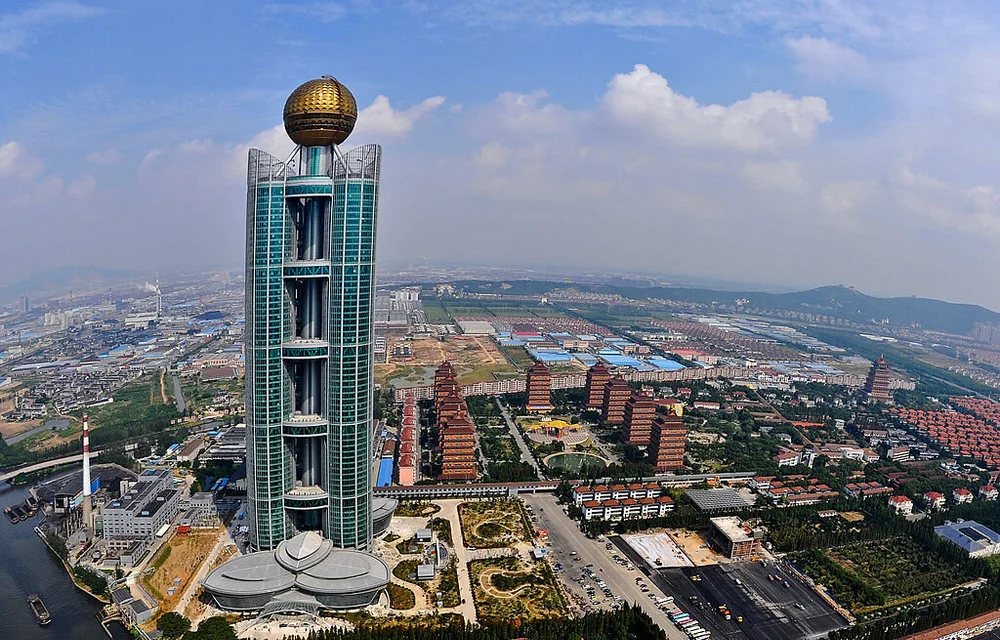
Longxi International Hotel, standing at 328 metres (1,082-feet) high and costing 470 million USD to build. It is one of China’s tallest buildings that belongs to Huaxi Village, and was once a symbol of China’s economic achievement, when it opened for business in 2011.
The picture you are seeing is the Longxi International Hotel, standing at 328 metres (1,082-feet) high and costing 470 million USD to build. It is one of China’s tallest buildings that belongs to Huaxi Village, and was once a symbol of China’s economic achievement, when it opened for business in 2011.
Now, let’s watch a short clip that was taken on Feb 24 this year.
Well, what you have just seen is hundreds of people lining up in the rain in front of a building in Huaxi Village. It looked like runs on banks by worried villagers seeking to withdraw their savings.
A Chinese language media, the Cover, later confirmed that the Chinese Communist Party (CCP) branch in Huaxi Village admitted that the video was authentic, but said that the village had no problem paying back its debts, as it had sufficient funds.
However, the public didn’t buy it. Rumors of Huaxi Village having gone bankrupt were flying all over the place.
So what are the real stories behind all these? And what can we learn from them? Let me start from the very beginning.
Loans and Steel: The First Bucket of Gold
Huaxi Village is located in Jiangyin City, Jiangsu Province in China, and was founded in 1962. See the red spot? That is where Huaxi Village is on the map of China. It is near the eastern coast, and not very far from Shanghai City.
Like many other villages in China in the 1960’s, Huaxi Village’s annual per capita income was less than 20 yuan ($3.03) then; and villagers struggled to make a living.
However, it had a different CCP secretary: Wu Renbao, who once worked for the government as a “state cadre”, and was assigned to the village to act as the party secretary.
Unlike other village officials, Wu Renbao had a very keen political sense and a business mind, as well as many contacts in government agencies.
In 1992, right after the then CCP leader Deng Xiaoping finished his famous southern tour and reinforced his “Reforms and Opening-up” policy, Wu Renbao immediately realized that there could be a good chance that China’s economy would take off soon.
He called an emergent meeting with key village cadres, and announced his judgment that economic development would inevitably lead to an increase in the price of raw materials.
So he decided on a strategy of “borrowing money to take maximum advantage of the situation”.
The village borrowed more than 80 million yuan ($12.2 million) and bought a large number of raw materials such as steel.
After Deng Xiaoping’s speech spread throughout China, the price of raw materials did rise a lot, and Huaxi Village was thus able to earn its “first bucket of gold” for further development.
However, a person close to Wu Renbao recently told the BBC that what helped Huaxi Village “get off the ground”was not Deng Xiaoping’s southern tour speech, but the “insider trading in steel raw materials”.
The fact that Wu Renbao could borrow 80 million yuan, including 60 million from banks, also shows that he had a very good relationship with both the government and the banks, which ordinary farmers don’t have.
Insider trading was very common in the early stage of China’s “Opening-up to the Outside World” in the 1980’s. At that time the so-called planned economy and market economy co-existed. The price of the same commodity inside the planned economy system was much lower than that in the market outside of the planned economy system. But you need a quota to buy commodities inside the planned economy system.
That is to say, if you are the children of CCP officials, or if you have good connections with CCP officials, you can buy a lot of cheap goods within the planned economy system, and sell them at the free market to make a huge amount of money.
Many people became rich in that way.
Actually, that was also one of the reasons for the 1989 Tiananmen Square protests. The protesters, many of them young students, were mainly protesting against the corruption, not really against the CCP.
A Socialist Revolution And A Flawless “Place of Dreams”
With the vast wealth accumulated from trading steel, Wu Renbao started a socialist revolution in Huaxi Village in the 1990s.
He pooled the villagers’ house land and built villas in a uniform style for each household, and established a free medical and educational system in the village.
Let’s show a picture of Huaxi village’s uniform style villas. Aren’t they magainficant?
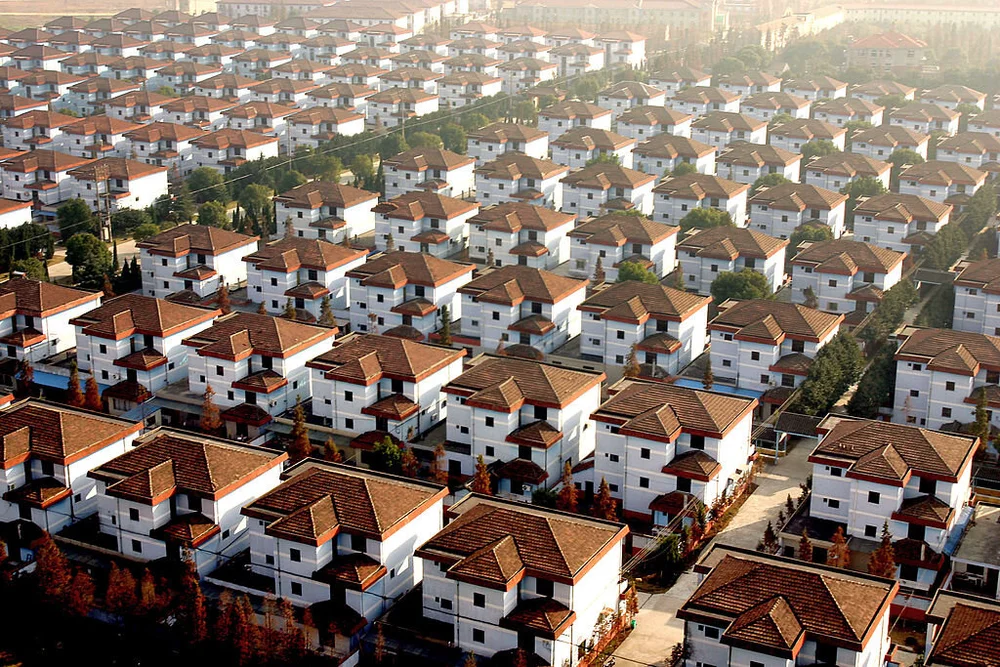
Huaxi village’s uniform style villas.
So everybody seemed to be enjoying a dream lifestyle of living in beautiful houses, driving luxury cars and having free food, medical coverage and education.
Isn’t everything looking magnificent again?
But, the problem is, the villagers only have the right to use the villas, or live in the villas, but do not own them, which means these villas can’t be traded in the market, and are not really the villagers’.
Wu Renbao also expropriated farmers’ farmland and built a large number of factories, including sock and textile plants. He encouraged villagers to work in the factories and set up the Huaxi Group, which is controlled by the Village Committee and gives villagers dividends at the end of each year.
Public information shows that the annual per capita wage of Huaxi villagers reached 122,600 yuan ($18,691) in 2004, which was 41.76 times the average wage of Chinese farmers and 13.01 times the average wage of urban residents.
However, only 20% of the group’s annual dividends to the villagers are paid in cash, and the rest goes directly into the Huaxi Village Committee. Villagers need to apply for permission to withdraw and use the funds when they need to deal with important events such as marriages, and sometimes the amount of payment will be reduced by the Village Committee with the excuse of “austerity”.
Under Wu Renbao’s iron fist rule for more than 40 years, Huaxi Village developed its economy in a “collective totalitarian” mode, which is “building fields in the 1970s, factories in the 1980s, and cities in the 1990s.”
By 1996, the entire village was living in a unified villa.
A promotional film “The Road to Huaxi” for visitors to watch claims that the village has achieved a perfect status with many “nos”: no gambling, no superstitious activities, no major criminal offenses, no petitions, no complaints, and no backstabbing, etc.
I couldn’t find that promotional film now, as it was taken down. But what you are seeing is something similar. It is a TV report produced by China Central Television, CCTV, in 2019, about what kind of great achievements Huaxi Village had made.
In this video, Huaxi Village is portrayed as completely cut off from the dark side of society and is a flawless “place of dreams”.
As a result, Huaxi Village has been regarded as “an advanced model that grew up under the guidance of Mao Zedong Thought, Deng Xiaoping Theory and the important thought of ‘Three Represents’ of Jiang Zemin”, and “a banner of rural development in China”.
As the person who was responsible for all the achievements, Wu Renbao had participated in many national and party congresses, and had been received by all the CCP General Secretaries including Jiang Zemin, Hu Jintao and Xi Jinping.
In 2005, Wu was featured on the cover of Time Magazine, and in August 2011, Huaxi Village bought the rights to broadcast an advertisement in Times Square in New York for $1 million, promoting itself as a “world renowned village”.
“Common Prosperity” Becomes One Family’s Kingdom
However, in 2008, Huaxi Village hit the ceiling of its development, and started to decline. The main industries that Huaxi Village had relied on, including textile and steel, began to go downhill.
Another big problem is, while Wu Renbao was the one who created the Huaxi miracle, his family also became the sole ruler of the village. All the important posts are taken by Wu’s family members.
According to the study in 2004 by Zhou Yi, a professor at Fudan University, the funds at the disposal of Wu Renbao’s four sons accounted for 90.7% of the total amount of Huaxi Village, while ordinary villagers were only given about one thousand yuan per month.
It was also revealed that the gorgeous appearance of Huaxi Village is by no means real. Huaxi villagers are called “the richest farmers”, but they actually cannot even meet the standards of normal people, because they are centrally monitored and managed, strictly forbidden from contacting outsiders. They even have to ask for permission if they want to leave the village.
In addition, villagers only have limited pocket money at their disposal. All other expenses have to be approved by the village.
Once villagers choose to leave the village, they must leave behind all their assets and wealth.
In the mealtime, while villagers can only use instead of owning their luxury items such as Mercedes-Benz cars, they are actually kidnapped into being actors and propagandists for the village, when all the visitors see them driving a luxury car.
In other words, although Huaxi Village claims that to achieve “common prosperity” is its ultimate mission, it has in fact become a kingdom for Wu Renbao’s family only.
After Wu Renbao died in 2013, his son Wu Xieen took over the Huaxi Group.
A Symbol of the Decline of Socialism and Collectivism
The news about Huaxi Village being nearly 40 billion yuan ($6.1 billion) in debt actually came out as early as 2019. However, Huaxi Village has never admitted it.
Recently a document from the Wuxi Municipal Government Office surfaced online, showing that the issue discussed at the 9th mayor’s meeting in 2019 was “hearing a report on the liquidity difficulty relief situation of Huaxi Group in Jiangyin City”.
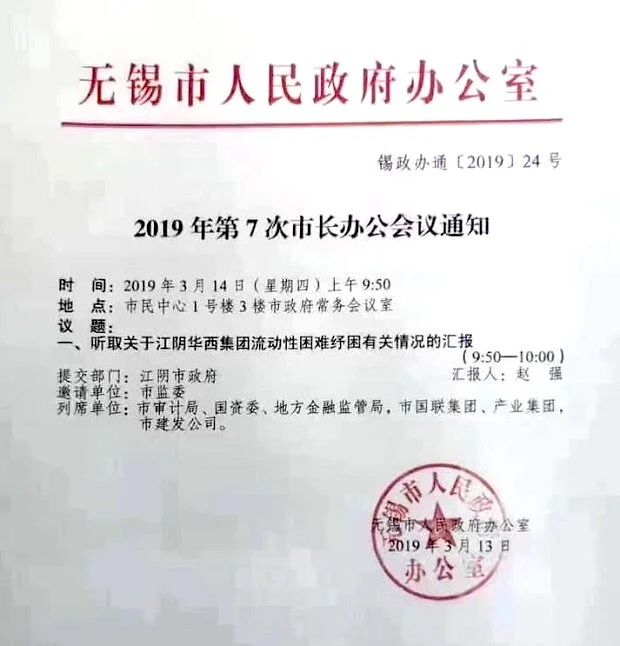
Document of Wuxi Municipal Government Office, showing that the issue discussed at the 9th mayor’s meeting in 2019 was “hearing a report on the liquidity difficulty relief situation of Huaxi Group in Jiangyin City”.
Public financial reports show that as of the third quarter of 2018, Huaxi Group had liabilities of 36.93 billion yuan ($5.63 billion), a debt ratio of 67.4% compared to its total assets.
I guess that is why we saw the video at the beginning of our show of people lining up in the rain to try to withdraw their money.
One villager who lined up on that day said that the reason why villagers panicked was that from February 24 on, Huaxi Group’s share dividends dropped sharply from 30 percent to 0.5 percent with no reasons provided. That is to say, people who make withdrawals after February 24 can only get a dividend of 0.5 percent instead of the promised 30 percent.
One villager showed a statement from Huaxi Group issued on Feb 24, showing that the interest rate is 0.5%, he was paid only 2252 yuan for his investment of 150,000 yuan made in 2018, 3 years ago.
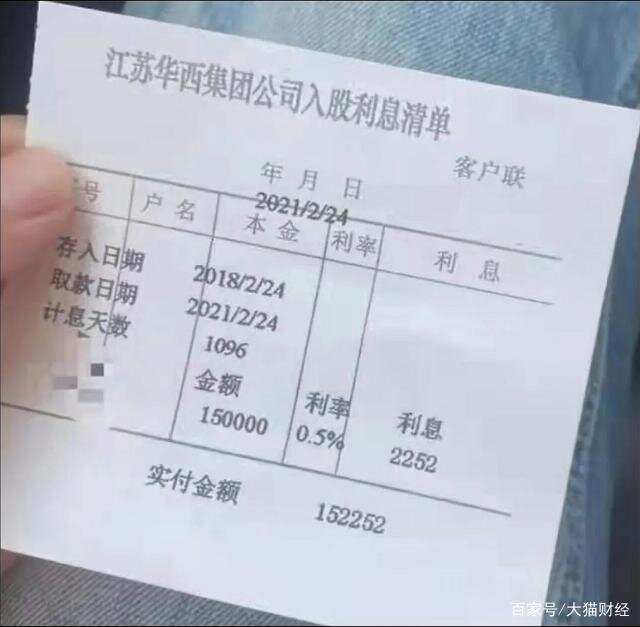
One villager showed a statement from Huaxi Group issued on Feb 24, showing that the interest rate is 0.5%, he was paid only 2252 yuan for his investment of 150,000 yuan made in 2018, 3 years ago.
Another villager showed an investment certificate showing that when he invested in Huaxi Group in 2018, the promised three year dividend was 30%.
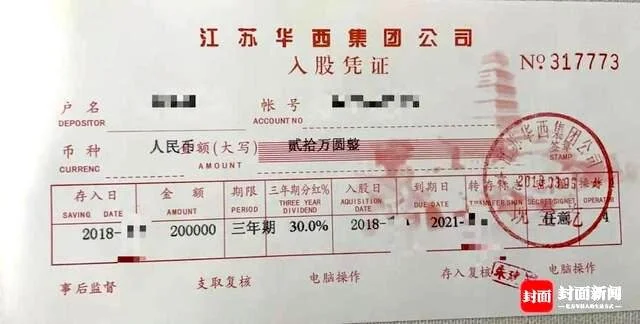
Another villager showed an investment certificate showing that when he invested in Huaxi Group in 2018, the promised three year dividend was 30%.
According to Chinese media Tencent, Huaxi Village has already gone bankrupt, with debts of more than 40 billion yuan ($6.1 billion), villagers’ villas are already mortgaged, but no one dares to take them over.
Actually, as early as 2012, Chinese scholar Wen Kejian wrote an article and said that Huaxi Village had become a symbol of the decline of socialism and collectivism.
He said, “The existence of Huaxi Village was originally a consolation for those old souls who still have illusions, and now this consolation symbol is no longer reliable, and people must make a choice about the future.”
Another Chinese financial analyst Caijinglengyan said recently that it is not at all surprising if Huaxi Village is crushed by debt and completely bankrupt. This fake, man-made miracle of collective economy will have to collapse one day, together with the ideology once touted by the CCP. And this day is getting closer and closer.
Well, what do you think about Huaxi Village’s story? I know many people in the West, especially young people, are very much attracted by socialist ideology. But the CCP alway tells us that socialism is the primary stage of communism, or socialism will inevitably lead to communism.
Huaxi Village once did look like a communist society that the CCP describes for us: everyone has abundant materials to enjoy, everyone is equal, everybody owns everything together.
But the reality is, in the name of everybody, power and wealth are taken over and controlled only by a few at the top, or the so-called government. In Huaxi’s case, it is the Village Committee. People lose their freedoms and are no longer individual human beings, while the rulers on top take care of everybody and everything.
Huaxi Village’s failed communist experiment once again tells us that the so-called Communism will never work. It is in essence evil that has only brought us disasters, no matter what kind of beautiful words it uses to deceive us, such as “equality and common prosperity for all”.
I hope no one will ever be fooled by it again.
OK, that’s all for today’s Inconvenient Truths. Thank you very much for watching. Please don’t forget to subscribe to my channel if you haven’t. Also, please make sure you share my channel and videos to at least one friend.
Thank you. See you soon!
4/8/2021 *
Truth Saves Lives. Subscribe and support! 真相能救命。請支持!
Donate to me directly 直接捐款:https://donorbox.org/inconvenient-truths-by-jennifer-zeng
Subscribestar 會員頻道: https://bit.ly/3fEzeJB
YouTube 油管:bit.ly/3b87DPj
GoFundme 衆籌:https://bit.ly/2zx6LVw
Patreon 網站:https://bit.ly/3cvBy3H
Paypal 捐款:http://paypal.me/JenniferZeng97
Bitcoin 捐款:bc1qlkkvwyvw96x3xx6jgzkhlnnv0nv3d9vm078vfd
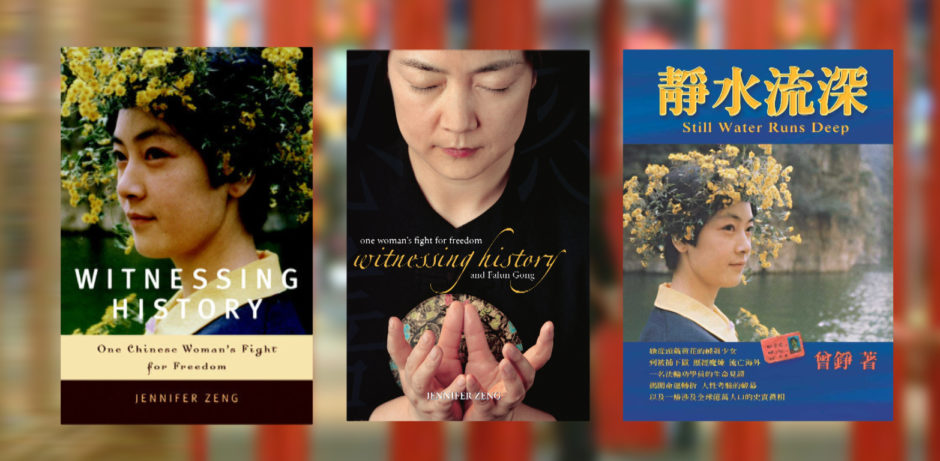
Huaxi Village: A Bursting Bubble of Communist Experiment
Hello, everyone, welcome to “Inconvenient Truths”. I am your host Jennifer Zeng.
For many people in the world, “equality and common prosperity for all” sounds so lofty and appealing. Who wouldn’t want to live in a society where everyone works together, enjoys “absolute equality and common prosperity”? You might say, no, such a society doesn’t exist in the world. How about I tell you that it does exist, or did exist once, and the only problem is, this society is now facing bankruptcy.
The society I am talking about is Huaxi Village in Jiangsu Province in China. It was once known as “the richest village in China”, and “the No. 1 village in the world” for decades, and many people went there to learn from their experiences, and pay respect.
Longxi International Hotel, standing at 328 metres (1,082-feet) high and costing 470 million USD to build. It is one of China’s tallest buildings that belongs to Huaxi Village, and was once a symbol of China’s economic achievement, when it opened for business in 2011.
The picture you are seeing is the Longxi International Hotel, standing at 328 metres (1,082-feet) high and costing 470 million USD to build. It is one of China’s tallest buildings that belongs to Huaxi Village, and was once a symbol of China’s economic achievement, when it opened for business in 2011.
Now, let’s watch a short clip that was taken on Feb 24 this year.
Well, what you have just seen is hundreds of people lining up in the rain in front of a building in Huaxi Village. It looked like runs on banks by worried villagers seeking to withdraw their savings.
A Chinese language media, the Cover, later confirmed that the Chinese Communist Party (CCP) branch in Huaxi Village admitted that the video was authentic, but said that the village had no problem paying back its debts, as it had sufficient funds.
However, the public didn’t buy it. Rumors of Huaxi Village having gone bankrupt were flying all over the place.
So what are the real stories behind all these? And what can we learn from them? Let me start from the very beginning.
Loans and Steel: The First Bucket of Gold
Huaxi Village is located in Jiangyin City, Jiangsu Province in China, and was founded in 1962. See the red spot? That is where Huaxi Village is on the map of China. It is near the eastern coast, and not very far from Shanghai City.
Like many other villages in China in the 1960’s, Huaxi Village’s annual per capita income was less than 20 yuan ($3.03) then; and villagers struggled to make a living.
However, it had a different CCP secretary: Wu Renbao, who once worked for the government as a “state cadre”, and was assigned to the village to act as the party secretary.
Unlike other village officials, Wu Renbao had a very keen political sense and a business mind, as well as many contacts in government agencies.
In 1992, right after the then CCP leader Deng Xiaoping finished his famous southern tour and reinforced his “Reforms and Opening-up” policy, Wu Renbao immediately realized that there could be a good chance that China’s economy would take off soon.
He called an emergent meeting with key village cadres, and announced his judgment that economic development would inevitably lead to an increase in the price of raw materials.
So he decided on a strategy of “borrowing money to take maximum advantage of the situation”.
The village borrowed more than 80 million yuan ($12.2 million) and bought a large number of raw materials such as steel.
After Deng Xiaoping’s speech spread throughout China, the price of raw materials did rise a lot, and Huaxi Village was thus able to earn its “first bucket of gold” for further development.
However, a person close to Wu Renbao recently told the BBC that what helped Huaxi Village “get off the ground”was not Deng Xiaoping’s southern tour speech, but the “insider trading in steel raw materials”.
The fact that Wu Renbao could borrow 80 million yuan, including 60 million from banks, also shows that he had a very good relationship with both the government and the banks, which ordinary farmers don’t have.
Insider trading was very common in the early stage of China’s “Opening-up to the Outside World” in the 1980’s. At that time the so-called planned economy and market economy co-existed. The price of the same commodity inside the planned economy system was much lower than that in the market outside of the planned economy system. But you need a quota to buy commodities inside the planned economy system.
That is to say, if you are the children of CCP officials, or if you have good connections with CCP officials, you can buy a lot of cheap goods within the planned economy system, and sell them at the free market to make a huge amount of money.
Many people became rich in that way.
Actually, that was also one of the reasons for the 1989 Tiananmen Square protests. The protesters, many of them young students, were mainly protesting against the corruption, not really against the CCP.
A Socialist Revolution And A Flawless “Place of Dreams”
With the vast wealth accumulated from trading steel, Wu Renbao started a socialist revolution in Huaxi Village in the 1990s.
He pooled the villagers’ house land and built villas in a uniform style for each household, and established a free medical and educational system in the village.
Let’s show a picture of Huaxi village’s uniform style villas. Aren’t they magainficant?
Huaxi village’s uniform style villas.
So everybody seemed to be enjoying a dream lifestyle of living in beautiful houses, driving luxury cars and having free food, medical coverage and education.
Isn’t everything looking magnificent again?
But, the problem is, the villagers only have the right to use the villas, or live in the villas, but do not own them, which means these villas can’t be traded in the market, and are not really the villagers’.
Wu Renbao also expropriated farmers’ farmland and built a large number of factories, including sock and textile plants. He encouraged villagers to work in the factories and set up the Huaxi Group, which is controlled by the Village Committee and gives villagers dividends at the end of each year.
Public information shows that the annual per capita wage of Huaxi villagers reached 122,600 yuan ($18,691) in 2004, which was 41.76 times the average wage of Chinese farmers and 13.01 times the average wage of urban residents.
However, only 20% of the group’s annual dividends to the villagers are paid in cash, and the rest goes directly into the Huaxi Village Committee. Villagers need to apply for permission to withdraw and use the funds when they need to deal with important events such as marriages, and sometimes the amount of payment will be reduced by the Village Committee with the excuse of “austerity”.
Under Wu Renbao’s iron fist rule for more than 40 years, Huaxi Village developed its economy in a “collective totalitarian” mode, which is “building fields in the 1970s, factories in the 1980s, and cities in the 1990s.”
By 1996, the entire village was living in a unified villa.
A promotional film “The Road to Huaxi” for visitors to watch claims that the village has achieved a perfect status with many “nos”: no gambling, no superstitious activities, no major criminal offenses, no petitions, no complaints, and no backstabbing, etc.
I couldn’t find that promotional film now, as it was taken down. But what you are seeing is something similar. It is a TV report produced by China Central Television, CCTV, in 2019, about what kind of great achievements Huaxi Village had made.
In this video, Huaxi Village is portrayed as completely cut off from the dark side of society and is a flawless “place of dreams”.
As a result, Huaxi Village has been regarded as “an advanced model that grew up under the guidance of Mao Zedong Thought, Deng Xiaoping Theory and the important thought of ‘Three Represents’ of Jiang Zemin”, and “a banner of rural development in China”.
As the person who was responsible for all the achievements, Wu Renbao had participated in many national and party congresses, and had been received by all the CCP General Secretaries including Jiang Zemin, Hu Jintao and Xi Jinping.
In 2005, Wu was featured on the cover of Time Magazine, and in August 2011, Huaxi Village bought the rights to broadcast an advertisement in Times Square in New York for $1 million, promoting itself as a “world renowned village”.
“Common Prosperity” Becomes One Family’s Kingdom
However, in 2008, Huaxi Village hit the ceiling of its development, and started to decline. The main industries that Huaxi Village had relied on, including textile and steel, began to go downhill.
Another big problem is, while Wu Renbao was the one who created the Huaxi miracle, his family also became the sole ruler of the village. All the important posts are taken by Wu’s family members.
According to the study in 2004 by Zhou Yi, a professor at Fudan University, the funds at the disposal of Wu Renbao’s four sons accounted for 90.7% of the total amount of Huaxi Village, while ordinary villagers were only given about one thousand yuan per month.
It was also revealed that the gorgeous appearance of Huaxi Village is by no means real. Huaxi villagers are called “the richest farmers”, but they actually cannot even meet the standards of normal people, because they are centrally monitored and managed, strictly forbidden from contacting outsiders. They even have to ask for permission if they want to leave the village.
In addition, villagers only have limited pocket money at their disposal. All other expenses have to be approved by the village.
Once villagers choose to leave the village, they must leave behind all their assets and wealth.
In the mealtime, while villagers can only use instead of owning their luxury items such as Mercedes-Benz cars, they are actually kidnapped into being actors and propagandists for the village, when all the visitors see them driving a luxury car.
In other words, although Huaxi Village claims that to achieve “common prosperity” is its ultimate mission, it has in fact become a kingdom for Wu Renbao’s family only.
After Wu Renbao died in 2013, his son Wu Xieen took over the Huaxi Group.
A Symbol of the Decline of Socialism and Collectivism
The news about Huaxi Village being nearly 40 billion yuan ($6.1 billion) in debt actually came out as early as 2019. However, Huaxi Village has never admitted it.
Recently a document from the Wuxi Municipal Government Office surfaced online, showing that the issue discussed at the 9th mayor’s meeting in 2019 was “hearing a report on the liquidity difficulty relief situation of Huaxi Group in Jiangyin City”.
Document of Wuxi Municipal Government Office, showing that the issue discussed at the 9th mayor’s meeting in 2019 was “hearing a report on the liquidity difficulty relief situation of Huaxi Group in Jiangyin City”.
Public financial reports show that as of the third quarter of 2018, Huaxi Group had liabilities of 36.93 billion yuan ($5.63 billion), a debt ratio of 67.4% compared to its total assets.
I guess that is why we saw the video at the beginning of our show of people lining up in the rain to try to withdraw their money.
One villager who lined up on that day said that the reason why villagers panicked was that from February 24 on, Huaxi Group’s share dividends dropped sharply from 30 percent to 0.5 percent with no reasons provided. That is to say, people who make withdrawals after February 24 can only get a dividend of 0.5 percent instead of the promised 30 percent.
One villager showed a statement from Huaxi Group issued on Feb 24, showing that the interest rate is 0.5%, he was paid only 2252 yuan for his investment of 150,000 yuan made in 2018, 3 years ago.
One villager showed a statement from Huaxi Group issued on Feb 24, showing that the interest rate is 0.5%, he was paid only 2252 yuan for his investment of 150,000 yuan made in 2018, 3 years ago.
Another villager showed an investment certificate showing that when he invested in Huaxi Group in 2018, the promised three year dividend was 30%.
Another villager showed an investment certificate showing that when he invested in Huaxi Group in 2018, the promised three year dividend was 30%.
According to Chinese media Tencent, Huaxi Village has already gone bankrupt, with debts of more than 40 billion yuan ($6.1 billion), villagers’ villas are already mortgaged, but no one dares to take them over.
Actually, as early as 2012, Chinese scholar Wen Kejian wrote an article and said that Huaxi Village had become a symbol of the decline of socialism and collectivism.
He said, “The existence of Huaxi Village was originally a consolation for those old souls who still have illusions, and now this consolation symbol is no longer reliable, and people must make a choice about the future.”
Another Chinese financial analyst Caijinglengyan said recently that it is not at all surprising if Huaxi Village is crushed by debt and completely bankrupt. This fake, man-made miracle of collective economy will have to collapse one day, together with the ideology once touted by the CCP. And this day is getting closer and closer.
Well, what do you think about Huaxi Village’s story? I know many people in the West, especially young people, are very much attracted by socialist ideology. But the CCP alway tells us that socialism is the primary stage of communism, or socialism will inevitably lead to communism.
Huaxi Village once did look like a communist society that the CCP describes for us: everyone has abundant materials to enjoy, everyone is equal, everybody owns everything together.
But the reality is, in the name of everybody, power and wealth are taken over and controlled only by a few at the top, or the so-called government. In Huaxi’s case, it is the Village Committee. People lose their freedoms and are no longer individual human beings, while the rulers on top take care of everybody and everything.
Huaxi Village’s failed communist experiment once again tells us that the so-called Communism will never work. It is in essence evil that has only brought us disasters, no matter what kind of beautiful words it uses to deceive us, such as “equality and common prosperity for all”.
I hope no one will ever be fooled by it again.
OK, that’s all for today’s Inconvenient Truths. Thank you very much for watching. Please don’t forget to subscribe to my channel if you haven’t. Also, please make sure you share my channel and videos to at least one friend.
Thank you. See you soon!
4/8/2021 *
Truth Saves Lives. Subscribe and support! 真相能救命。請支持!
Donate to me directly 直接捐款:https://donorbox.org/inconvenient-truths-by-jennifer-zeng
Subscribestar 會員頻道: https://bit.ly/3fEzeJB
YouTube 油管:bit.ly/3b87DPj
GoFundme 衆籌:https://bit.ly/2zx6LVw
Patreon 網站:https://bit.ly/3cvBy3H
Paypal 捐款:http://paypal.me/JenniferZeng97
Bitcoin 捐款:bc1qlkkvwyvw96x3xx6jgzkhlnnv0nv3d9vm078vfd